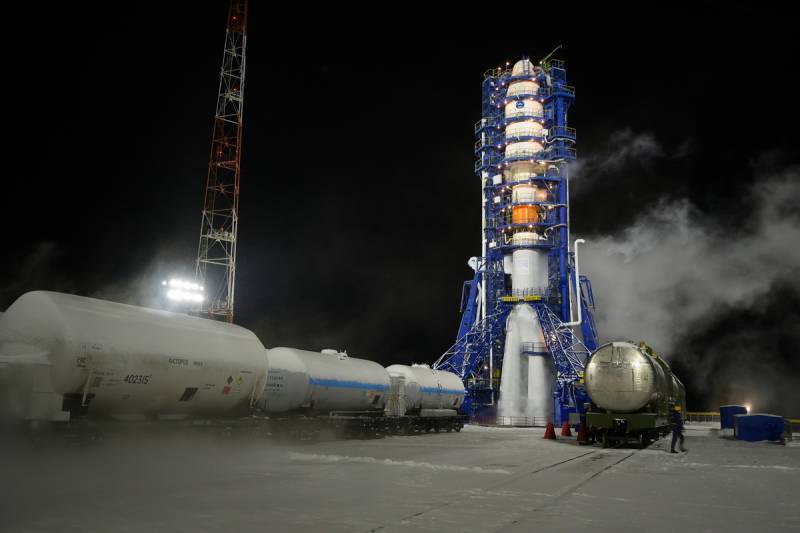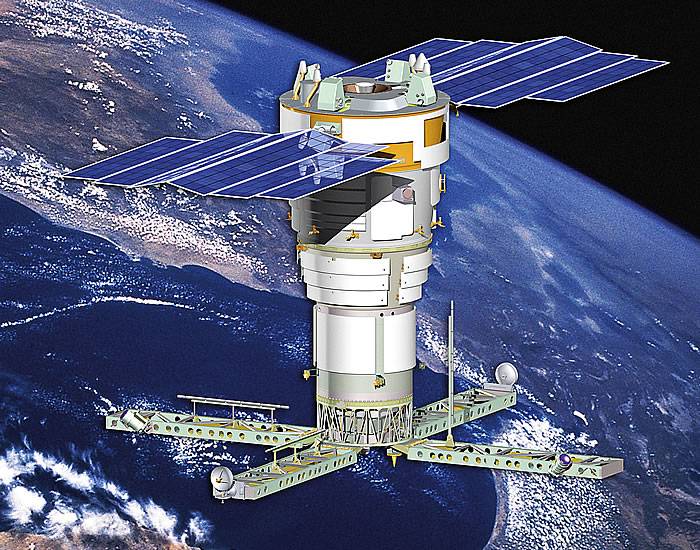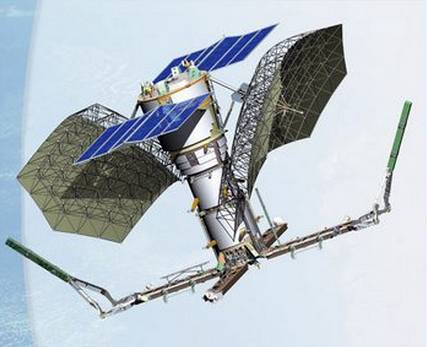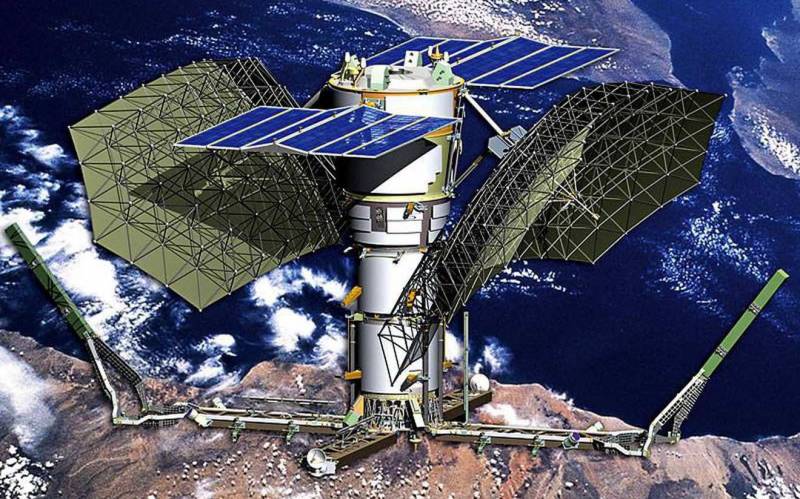The first "Pion-NKS" in operation: successes in the construction of the ICRC "Liana" system

Preparations for the launch of the satellite "Lotos-C1" / "Cosmos-2549", February 2021
For a long time in the interests of the naval fleet a promising system of marine space reconnaissance and target designation (MKRTS) 14K159 "Liana" is being built. Recently, another satellite from this system was tested and accepted by the customer, and now work is beginning on the next one. After its launch and commissioning, Liana will acquire its final form and will be able to fully solve the assigned tasks.
New satellite
Last year, the second stage of the deployment of the Liana ICRC began, providing for the launch of 14F139 Pion-NKS active radar reconnaissance satellites into orbit. Over the past few years, domestic enterprises have been developing, building and preparing for the launch of the first apparatus of this type.
On June 25, 2021, the Soyuz-2.1b carrier rocket, having launched from the Plesetsk cosmodrome, launched the lead Pion-NKS, which received the military designation Kosmos-2550, into orbit. The launch took place normally, and at the specified time the spacecraft entered the calculated orbit. The Space Forces established contact with him and began preparations for testing.
The tests of the 14F139 satellite lasted more than a year, and the completion of these activities became known only a few days ago. On November 10, the TASS agency, citing its source in the rocket and space industry, reported that Pion-NKS had passed the tests and was highly appreciated by the Ministry of Defense and the Navy command. Based on the results of the checks, the device was accepted by the customer.
A TASS source recalled that the received satellite is the first of two planned. Completion of work on it allows you to start manufacturing the next one. Related issues are now being discussed, but details of this process are not given.
Information on the timing of the start of construction of the second Pion-NKS is not yet available. When it will be launched into orbit is also unknown. However, current developments give cause for optimism. TASS and the source note that the deployment of the Liana ICRC system will be completed in the near future.

"Lotos-S" in working configuration
Completed work
The development of a promising ICRC, which received the code "Liana", started in the middle of the 120s by order of the Ministry of Defense. The Almaz-Antey concern was appointed as the lead contractor. At different stages, more than XNUMX enterprises and organizations were involved in scientific, technical and development work.
Over the next few years, the necessary studies were carried out, the general appearance of the future ICRC system was developed, and spacecraft designs were created from its composition. According to the project, "Liana" is a space-based electronic intelligence system and is intended to track ships and ship groups in the oceans.
The 14K159 Liana system includes three types of satellites carrying reconnaissance equipment. The device type 14F138 "Lotos-S", developed in the first place, is equipped with passive type devices. There is also its upgraded version 14F145 "Lotos-S1". The newer project 14F139 "Pion-NKS" provides for the use of active radio systems. The full "constellation" of the system according to the project consists of five passive reconnaissance satellites and two active ones.
The deployment of the Liana system began in November 2009. Then the Soyuz-U rocket with the Cosmos-2455 satellite on board was launched from the Plesetsk cosmodrome - it was the Lotos-S head product. The satellite showed itself not in the best way, but the tests were completed and put into operation.
Taking into account the experience of the 14F138 project, a modernized Lotos-S1 was developed. In 2014, 2017, 2018 and 2021 four such satellites were launched into orbit. To date, all of them have begun full-fledged work and are monitoring different regions of the planet.
Active intelligence
In the mid-14s, work began on the creation of an active echelon of the intelligence system. The 139FXNUMX Pion-NKS satellite was developed by several organizations, and then the assembly of the head product of this type began. The creation of such a spacecraft encountered certain difficulties and dragged on.

Active reconnaissance satellite "Pion-NKS"
However, the construction was completed, and in 2020-21. preparations for launch began. The first Pion-NKS was sent into orbit in June 2021 under the designation Cosmos-2550. Subsequently, the apparatus confirmed the calculated characteristics and entered into operation.
In addition, Cosmos-2550 showed the potential and capabilities of the new project, which allows us to continue work. Now the industry will have to manufacture a second satellite of the 14F139 type and send it into orbit. The exact dates have not yet been reported - only general formulations are used.
The Liana project provides for the use of only two Pion-NKS satellites. This means that the next device of this type will make it possible to complete the deployment of the ICRC system, and then organize its full-fledged operation in the interests of the fleet and, possibly, other branches of the armed forces.
Intelligence and target designation
The general architecture and operating principles of the 14K159 Liana marine space reconnaissance and target designation system are already known. Seven satellites with active and passive reconnaissance instruments will operate in circular orbits with an altitude of 800-900 km. The orbits and the position of the devices on them are determined in such a way as to ensure observation of all the main sections of the World Ocean.
Satellites "Lotos-S (1)" are equipped with electronic intelligence equipment that works only for reception. They must monitor the air at different frequencies and isolate the signals of shipborne radars, communication systems, etc. The onboard equipment of the satellite allows not only to detect the signal, but also to determine the approximate location of its source.
To more accurately determine the coordinates of a ship or order, as well as to identify objects that observe radio silence, Pion-NKS active reconnaissance satellites are intended. Such a device carries a compact radar station and is capable of detecting almost any surface objects.

Data on detected targets is transmitted via existing communication systems to the headquarters of the armed forces and the Navy. Further, this information can be used to issue target designation to strike assets. This role can be played by aircraft of the Aerospace Forces or a naval aviation, missile systems of ships or submarines, etc.
In the past, the "Legend" system was used to solve the problems of space reconnaissance of marine targets. The first satellites from its composition went into orbit in the early seventies, and in 1978 the finished system entered service. The operation of the "Legend" continued until the XNUMXs, after which it was decided to stop updating its "constellation". At the same time, the development of the promising Liana began.
The new MKRTS 14K159 system has a number of important advantages over the decommissioned "Legend". First of all, it's new. Satellites of modern types are based on the actual element base and have a better combination of technical and operational characteristics. In addition, fewer spacecraft are required in orbit.
The advantages of the new "Liana" are already being used in practice. The main part of the satellites has been put into operation and is carrying out reconnaissance. In the coming years, the second Pion-NKS apparatus will join them, and this will complete the construction of the system. However, it should be expected that the launches of new technology will continue. New satellites will be sent into orbit to replace the exhausted ones.
At the finish line
Thus, the program for the creation of a new system of marine space reconnaissance and target designation "Liana", despite objective difficulties, is nearing completion. It remains to manufacture and launch into orbit only one new satellite, after which the system will acquire a design look and receive full capabilities.
As a result of these processes, our space forces and the navy will again have the opportunity to observe the entire oceans and track the ships of a potential enemy. A complete satellite constellation with such capabilities has not been available for the past few years, but now it has been recreated.
- Ryabov Kirill
- Ministry of Defense of the Russian Federation, MZ "Arsenal"
Information